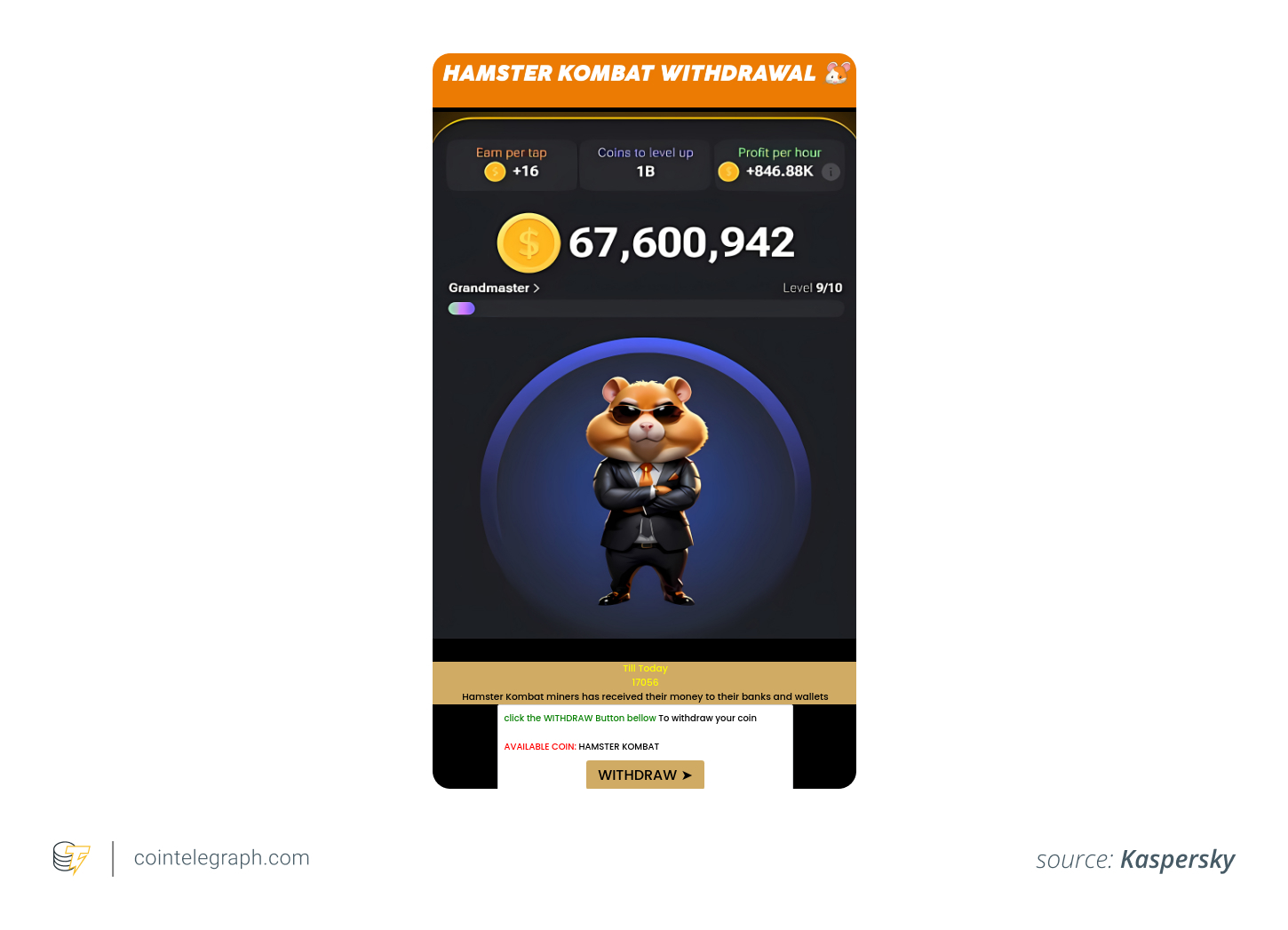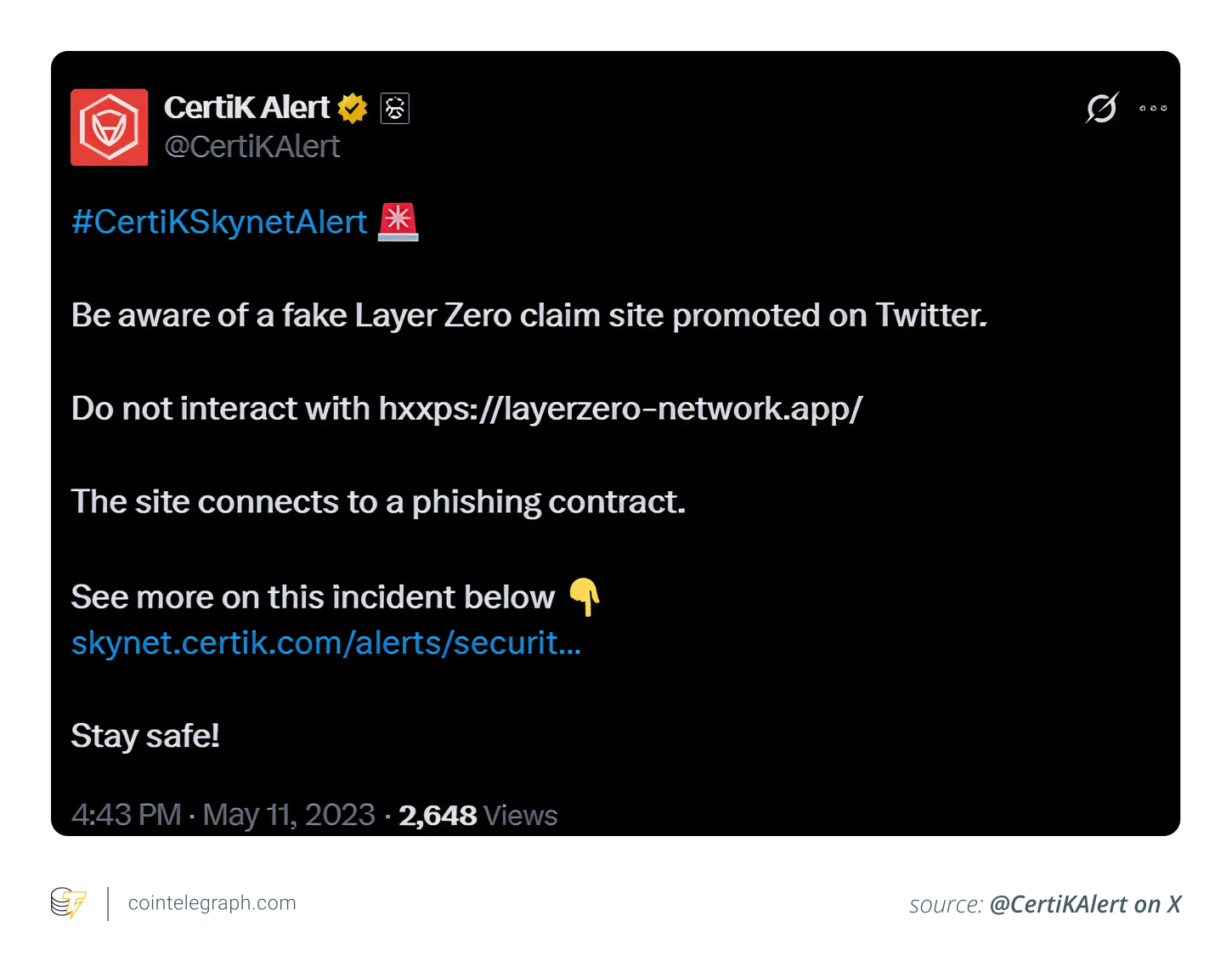Key takeaways
-
In 2024 and 2025, fake airdrop scams targeting Hamster Kombat, Wall Street Pepe and others led to millions in user losses, contributing to over $9.9 billion in global crypto scam damages.
-
Fake airdrops impersonate legitimate projects, tricking users into revealing private keys, signing malicious contracts or paying upfront fees that lead to irreversible crypto theft.
-
Warning signs include no official announcement, suspicious URLs, requests for private keys, grammar errors and unrealistic reward promises.
-
Future airdrops are shifting toward activity-based, retroactive and AI-monitored models that reward genuine user engagement while reducing exploitation.
While cryptocurrency airdrops are a legitimate way for projects to gain publicity and users, scammers exploit this hype, draining wallets through fake campaigns. In 2024 and 2025, fake airdrop scams around projects like Hamster Kombat and Wall Street Peepe cost victims millions. According to Chainalysis, the global estimated losses in 2024 from cryptocurrency scams and fraud, which included fake airdrops, amounted to at least $9.9 billion.
Spotting red flags is crucial to staying safe from fake airdrops. This article explores key warning signs and practical tips to protect your funds.
What are fake airdrops?
Airdrops are a common practice of distributing free tokens in the crypto world as part of marketing campaigns, user acquisition efforts, or community-building exercises. Legitimate airdrops reward early takers, increase token visibility, or promote network activity. Getting airdrops requires minimal effort, like signing up, joining a community or holding a specific token.
However, the popularity of airdrops has also drawn scammers. They exploit user greed and curiosity by promising free tokens (fake airdrops) in exchange for sensitive actions such as sharing private keys, signing malicious contracts or paying gas fees. Fraudsters may impersonate real projects using spoofed domains or fake social media accounts.
These scams often look convincing, and even experienced users can fall victim. This is the reason consistent vigilance is required when you are getting airdrops.
Did you know? In 2023, Inferno Drainer helped scammers steal over $80 million through airdrop phishing campaigns. Operating as a “drainer-as-a-service,” it lets affiliates use prebuilt kits to run scam airdrop sites, targeting wallets across several blockchains.
Key red flags that expose ‘fake airdrops’
Before you connect for an airdrop, learn to spot the warning signs. These red flags are your first line of defense against losing your crypto or sensitive information to scammers:
1. No official announcement from verified channels
-
What to watch for: A major warning sign of a fake airdrop is the lack of any announcement on the project’s official communication channels. Scammers often use unsolicited direct messages, unofficial Telegram groups or poorly crafted websites mimicking legitimate ones to promote fake airdrops.
-
How to avoid: Always verify the legitimacy of an airdrop by checking the project’s official website, verified X account or official Discord/Telegram channels before clicking any links. If the airdrop isn’t mentioned there, keep away from it.
2. Request for private key or seed phrase
-
What to watch for: A critical red flag of a fake airdrop is a request to “verify” your wallet by providing your private key or seed phrase. These scams deceive users into surrendering complete control of their crypto wallets by posing as eligibility checks. Once shared, scammers can immediately steal all assets.
-
How to avoid: Genuine airdrops never ask for your private key or recovery phrase, which should always remain confidential. If anyone or any website requests these, it is a clear scam. Exit the page immediately.
3. Upfront gas fees or crypto payments
-
What to watch for: A significant warning sign of a fake airdrop is that it requires upfront gas fees or cryptocurrency payments to “unlock” tokens. Scammers often insist you send Ether (ETH) or other coins to claim rewards, but after the payment, the promised tokens never materialize, and your funds are lost.
-
How to avoid: Legitimate airdrops are free, typically involving only simple tasks like connecting a wallet or completing minor actions. If an airdrop demands any payment, it is likely to be a scam. Never send funds to unfamiliar addresses.
4. Suspicious URLs or clone sites
-
What to watch for: Fake airdrops frequently employ phishing websites resembling legitimate crypto platforms. These sites aim to deceive users into connecting wallets and signing fraudulent transactions.
-
How to avoid: You need to carefully check a project’s URL before executing any transaction on it. There will likely be subtle differences, such as misspellings, extra characters or alternate domain extensions.
Did you know? Some airdrops use retroactive criteria, rewarding users based on past activity. This encourages organic participation before the airdrop announcement, so simply using DApps naturally could make you eligible for future free tokens.
5. Poor grammar and urgent language
-
What to watch for: Many fake airdrops feature poor grammar, spelling errors or aggressive phrases like “Claim Now Or Lose Out!” or “Final Chance For Free Tokens!” These tactics aim to create panic, rushing users into clicking malicious links without careful thought. Sloppy writing and intense urgency are clear signs of a scam.
-
How to avoid: Legitimate crypto projects communicate professionally and clearly. If an airdrop announcement contains errors or uses high-pressure, time-sensitive language, steer clear.
6. Fake social proof or bot comments
-
What to watch for: Scammers frequently use fake airdrop posts filled with fabricated social proof, such as comments like “I just got 500 $XYZ!” or “Totally legit!” These are often posted by bots or fake accounts to create a false sense of trust and encourage participation. They might also use fake or hacked celebrity accounts to disseminate false information regarding airdrops.
-
How to avoid: Avoid trusting social media comments alone to determine an airdrop’s legitimacy. Research the token thoroughly, confirm its presence on reputable platforms, and seek authentic user feedback on forums like Reddit or trusted crypto Discord groups. Genuine projects maintain transparent communities, not just artificial hype.
7. Unknown or nonexistent token projects
-
What to watch for: Certain fake airdrops promote tokens tied to obscure or nonexistent projects, which might lack a white paper, roadmap, official website or verifiable team. Scammers use these fabricated tokens to trick users into connecting wallets or approving transactions that result in stolen funds.
-
How to avoid: Always research a token extensively before participating in an airdrop. Check for a white paper, official website, team credentials and active community presence. If the project lacks basic details or appears suspiciously new with no credible background, it is likely fraudulent.
8. Token approval traps
-
What to watch for: Certain fake airdrops entice users to connect their wallets and grant token spending permissions. These seemingly harmless “approval” requests can allow scammers to freely transfer or drain your tokens without further interaction, exploiting the granted permissions.
-
How to avoid: Exercise caution when approving token transactions, particularly from unfamiliar sources. Avoid authorizing smart contract interactions on untrusted websites. Regularly use tools like revoke cash to check and cancel unnecessary token approvals.
9. Redirects to malicious wallet drainers
-
What to watch for: Some fake airdrop links redirect users to malicious DApps known as wallet drainers. These sites are designed to resemble legitimate claim pages but execute malicious smart contracts once a wallet is connected. By clicking “claim airdrop,” users unknowingly sign transactions that give scammers full access to their funds.
-
How to avoid: Always review transaction pop-ups carefully before signing. Use browser wallets like MetaMask with built-in phishing protection and stay updated on known scam domains. If a site looks unfamiliar or triggers unexpected approvals, disconnect immediately.
10. Unrealistic reward promises
-
What to watch for: Fake airdrops often attract users with unrealistic promises, such as “Instantly claim $2,000 in free tokens!” with no effort required. These offers exploit greed and curiosity, luring users into connecting wallets or signing transactions without proper scrutiny.
-
How to avoid: Be suspicious of extravagant claims. Genuine airdrops usually provide modest rewards and have certain eligibility criteria. If an offer appears too good to be true, it is likely to be fraudulent.
Did you know? In 2021, the Ethereum Name Service (ENS) gave governance tokens via an airdrop to anyone who had registered a .eth name. Many ENS holders received thousands of dollars just for owning a crypto domain name.
Examples of fake airdrops
Here are some examples of well-known fake airdrops to help you understand how these fraudulent actions scam unsuspecting victims:
Hamster Kombat
Hamster Kombat is a Telegram-based tap-to-earn game where players manage a virtual crypto exchange as a hamster CEO. By tapping, completing daily tasks and upgrading, players earn HMSTR coins, which are convertible to tradable tokens. Launched in March 2024, it attracted over 250 million users, but scams targeting players have raised concerns.
Malicious actors targeted Hamster Kombat to profit from the tap-to-earn game’s viral popularity. Kaspersky warned users about fake Hamster Kombat airdrops, meant to steal victims’ crypto wallet credentials.

Wall Street Pepe
Wall Street Pepe ($WEPE) is an Ethereum-based memecoin that combines meme culture with practical trading utilities. Inspired by the Pepe meme and Wall Street trading, $WEPE provides small traders with unique market insights, strategic analysis and a supportive community.
The $WEPE airdrop scam mimicked the legitimate token’s website. It lured users with promises of an airdrop and prompted them to connect their digital wallets, inadvertently signing malicious contracts that drained their assets.

HEX
HEX is a token built on Ethereum to help users capitalize on cryptocurrency market growth through a system that supports coin locking and staking for fixed durations.
The fraudulent webpage replicated the official HEX site. The airdrop on this counterfeit site was fake and unrelated to the genuine HEX project or other initiatives. When a crypto wallet was linked to the deceptive site, it activated a malicious contract that enabled the cryptocurrency drainer to steal funds.

Sui
Sui (SUI) is a layer-1 blockchain and smart-contract platform engineered for speed, privacy and accessibility, featuring a distinctive object-centric data model.
When users checked airdrop eligibility on the fraudulent webpage posted by the scammers, they were prompted to link their digital wallets. This action unwittingly signed a malicious contract, enabling the cryptocurrency drainer. Consequently, their funds were automatically transferred to wallets controlled by scammers through seamless, unauthorized transactions.

LayerZero
The LayerZero airdrop implemented a novel “proof-of-donation” claiming system. Instead of distributing $ZRO tokens for free, as typical airdrops do, LayerZero required users to donate $0.10 per token to the Protocol Guild, which supports Ethereum’s core developers.
In July 2023, security firm CertiK cautioned users to be careful about fake airdrops being promoted on X by accounts impersonating Layer Zero. When users clicked on the links, they were sent to a website that resembled the official LayerZero website.

How crypto airdrops are evolving from freebies to secure community rewards
Crypto airdrops are advancing beyond basic token giveaways, adopting more advanced and secure approaches to engage users. Projects increasingly implement activity-based airdrops, rewarding users for contributions like staking, testing apps or engaging in governance. This shift seeks to promote authentic community involvement and prevent exploitative tactics.
Novel distribution models such as snapshot-based allocations and retroactive rewards are gaining traction. These approaches enhance transparency and ensure tokens reach active community contributors. Integrating artificial intelligence and machine learning improves fraud detection and strengthens airdrop security by helping detect bots, fake wallets and fraudulent behavior, making airdrops more secure and resistant to exploitation.
This transformation reflects the evolution of responsible, effective token distribution practices that align with decentralization and community empowerment goals.
This article does not contain investment advice or recommendations. Every investment and trading move involves risk, and readers should conduct their own research when making a decision.



















